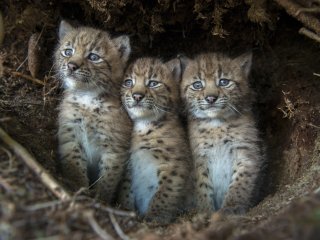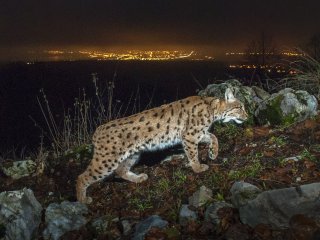The Lynx and Us
A forest is more than trees, it is a web of life. It is complex and includes many thousands of different organisms all performing an important role, from the plants that make up the different layers of the forest to the fungi that help to recycle nutrients by decomposing dead material. Animals feed on the plants and each other to help ensure a natural balance. Crucial to this natural balance are the predators because they help to ensure there are not too many other animals eating the plants. All of the large predators, like wolves and bears, have been lost from Scotland because of human persecution. This is one reason why the forest cannot recover outside fences in the Highlands because there are so many deer that eat every tree seedling they find.
Trees for Life has long advocated the return of lost predators, but we know that this is a major decision that it is fraught with difficulties. The Eurasian lynx has often been seen by conservationists as the easiest predator to reintroduce because they are secretive felines which rarely cause conflict with human activities. However, few people know much about this medium sized cat so its reintroduction is regarded with suspicion and great concern. A new book, ‘The Lynx and Us’ by Dr David Hetherington, a Trees for Life Board Member, seeks to dispel the myths and present a balanced view on lynx reintroduction. David is one of the UK’s leading experts on the species.

‘The Lynx and Us’ demonstrates there is enough room for a self-sustaining population of about 400 lynx in the north of Scotland. The book shows how they would help to control deer numbers, especially roe deer, which would help restore natural balance to Scotland’s forests. It also highlights their potential as a tourist attraction (while admitting that they will be very difficult to see because they are so secretive).
‘The Lynx and Us’ makes it clear that these animals may occasionally come in to conflict with humans but that this is highly unlikely. For example, only rabid lynx have ever attacked humans and they only prey on sheep which are grazing in forests because they don’t hunt over open ground. Sometimes hunters illegally persecute lynx in Europe because they are thought to reduce deer numbers so much it affects their sport. Since rabies does not exist in the UK, sheep grazing in forests is not widely practiced and our problem in Scotland is too many deer rather than too few, the book indicates there is a great opportunity to bring back this magnificent animal with few problems.

There are perhaps two main barriers preventing the reintroduction of lynx. The first is the perception of the farming community that lynx will take their livestock and the second is a lack of willingness by the Scottish government to support species reintroductions, mainly because of the problems associated with the illegal release of beaver on the River Tay. However, anyone with an open mind that takes the time to read ‘The Lynx and Us’ will quickly realise we have more to gain by reintroduction than anyone has to lose, and if the reintroduction was managed properly the potential for conflict would be very small.
While lynx are starting to return to some of their former areas in mainland Europe, sometimes by natural dispersal, the only way they will ever return to the UK is if we deliberately reintroduce them. ‘The Lynx and Us’ provides a very powerful case for this, but with a strong note of caution that it will only succeed if it is done properly and with consideration to those who feel their livelihood is threatened by the return of Scotland’s big cat. Whatever your current view on the reintroduction of large predators to the UK, ‘The Lynx and Us’ will help you decide whether this particular species has a future in our landscape.
Copies of ‘The Lynx and Us’ can be ordered through the publishers – Scotland The Big Picture by following this link: https://www.scotlandbigpicture.com/Store/books/the-lynx-and-us

